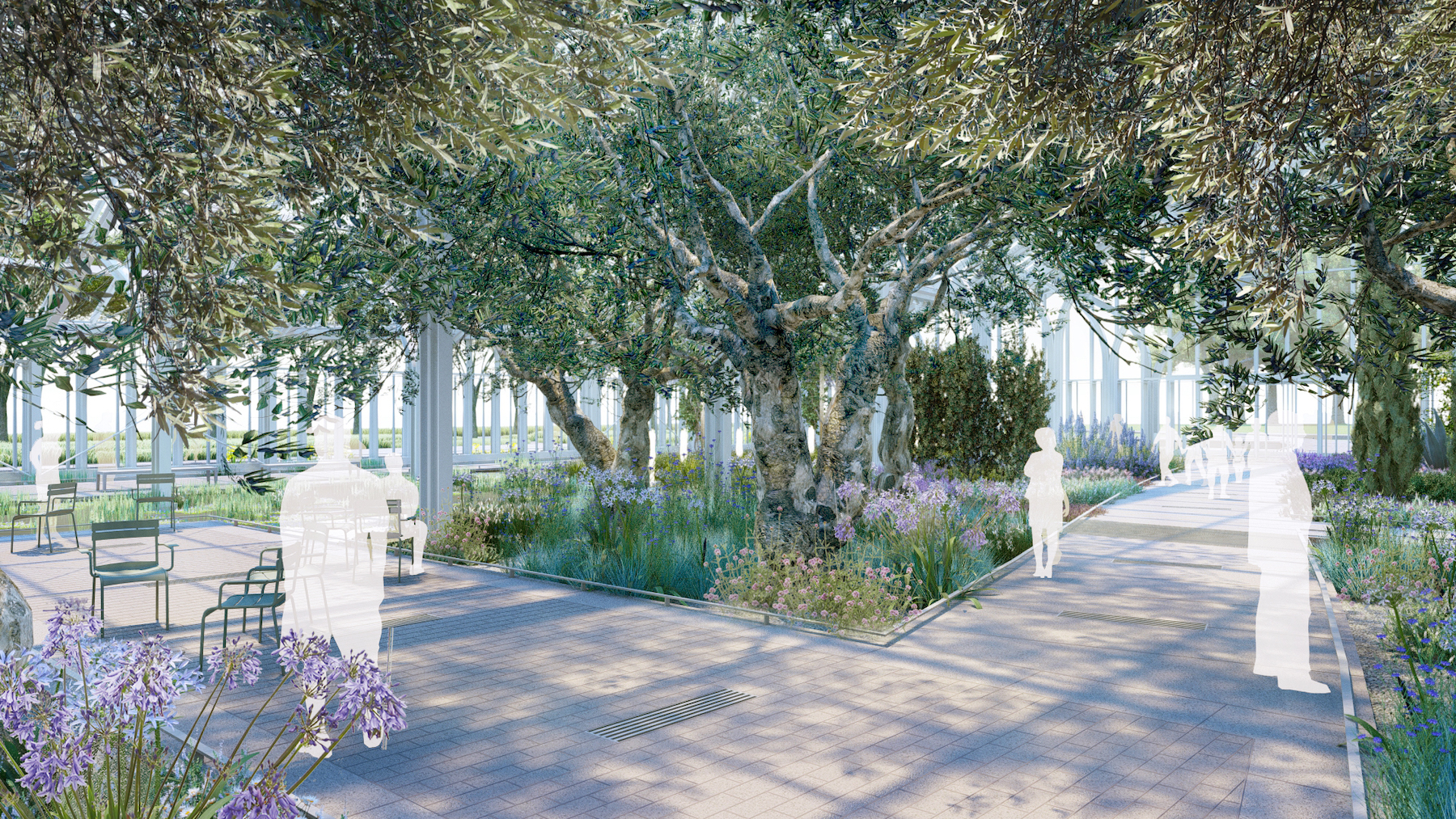Longwood Gardens, a botanical garden with about 1,100 acres in Pennsylvania’s Brandywine Valley, recently announced plans to transform its core area of conservatory gardens. Across 17 acres, the $250 million project will include expanded gardens and public spaces as well as new buildings.
Dubbed Longwood Reimagined: A New Garden Experience, the project originated with a master plan developed in 2010 by West 8 with Weiss/Manfredi. Longwood has continued working with Weiss/Manfredi as lead designer, in collaboration with Reed Hilderbrand, on Longwood Reimagined. The project is managed by Bancroft Construction.
The centerpiece and largest element of Longwood Reimagined is a new 32,000-square-foot glasshouse, designed by Weiss/Manfredi, with gardens and pools designed by Reed Hilderbrand. With asymmetrical peaks, the West Conservatory will seem to float on water. Inside, the garden will comprise seasonally changing islands amid pools, canals, and low fountains. Building on the 19th-century tradition of glasshouses, the West Conservatory will include operable glass walls and roof.
Longwood’s Cascade Garden is being entirely relocated to a new, 3,800-square-foot glasshouse of its own. An outdoor Bonsai Courtyard will be built alongside the West Conservatory. A public restaurant and private event space will be carved into the topography facing the Main Fountain Garden. And above the restaurant and event space, the South Terrace and South Walk will provide a shady promenade extending along the conservatories to the West Terrace, with views toward the Brandywine’s meadows.
Other elements of the Longwood Reimagined project include the construction of an education and administration building with a library and classrooms, the renewal of the Waterlily Court, and the relocation and preservation of six historic Lord & Burnham glasshouses from the early 20th century.
Building Team:
Owner: Longwood Gardens
Design architect: Weiss/Manfredi, Reed Hilderbrand (landscape)
Architect of record: Weiss/Manfredi
MEP engineer: Jaros, Baum & Bolles
Structural engineer: Magnusson Klemencic Associates
General contractor/construction manager: Bancroft Construction



Related Stories
| Aug 11, 2010
Bowing to Tradition
As the home to Harvard's Hasty Pudding Theatricals—the oldest theatrical company in the nation—12 Holyoke Street had its share of opening nights. In April 2002, however, the Faculty of Arts and Sciences decided the 1888 Georgian Revival building no longer met the needs of the company and hired Boston-based architect Leers Weinzapfel Associates to design a more contemporary facility.
| Aug 11, 2010
AIA course: MEP Technologies For Eco-Effective Buildings
Sustainable building trends are gaining steam, even in the current economic downturn. More than five billion square feet of commercial space has either been certified by the U.S. Green Building Council under its Leadership in Energy and Environmental Design program or is registered with LEED. It is projected that the green building market's dollar value could more than double by 2013, to as muc...
| Aug 11, 2010
BIM adoption tops 80% among the nation's largest AEC firms, according to BD+C's Giants 300 survey
The nation's largest architecture, engineering, and construction companies are on the BIM bandwagon in a big way, according to Building Design+Construction's premier Top 50 BIM Adopters ranking, published as part of the 2009 Giants 300 survey. Of the 320 AEC firms that participated in Giants survey, 83% report having at least one BIM seat license in house, half have more than 30 seats, and near...
| Aug 11, 2010
Thrown For a Loop in China
While the Bird's Nest and Water Cube captured all the TV coverage during the Beijing Olympics in August, the Rem Koolhaas-designed CCTV Headquarters in Beijing—known as the “Drunken Towers” or “Big Shorts,” for its unusual shape—is certain to steal the show when it opens next year.
| Aug 11, 2010
Robert F. Kennedy Main Justice Building
The Robert F. Kennedy Main Justice Building houses the U.S. Attorney General's office, the Justice Department headquarters, and the largest historic art collection of any GSA-built facility, so its renovation had to be performed with the utmost care. Offices housing hundreds of lawyers and staff had to remain operational during the construction of a brand new $3.
| Aug 11, 2010
Silver Award: Please Touch Museum at Memorial Hall Philadelphia, Pa.
Built in 1875 to serve as the art gallery for the Centennial International Exhibition in Fairmount Park, Memorial Hall stands as one of the great civic structures in Philadelphia. The neoclassical building, designed by Fairmount Park Commission engineer Hermann J. Schwarzmann, was one of the first buildings in America to be designed according to the principles of the Beaux Arts movement.
| Aug 11, 2010
Bronze Award: Garfield High School, Seattle, Wash.
Renovations to Seattle's historic Garfield High School focused mainly on restoring the 85-year-old building's faded beauty and creating a more usable and modern interior. The 243,000-sf school (whose alumni include the impresario Quincy Jones) was so functionally inadequate that officials briefly considered razing it.
| Aug 11, 2010
Managing the K-12 Portfolio
In 1995, the city of New Haven, Conn., launched a program to build five new schools and renovate and upgrade seven others. At the time, city officials could not have envisioned their program morphing into a 17-year, 44-school, $1.5 billion project to completely overhaul its entire portfolio of K-12 facilities for nearly 23,000 students.
| Aug 11, 2010
Tall ICF Walls: 9 Building Tips from the Experts
Insulating concrete forms have a long history of success in low-rise buildings, but now Building Teams are specifying ICFs for mid- and high-rise structures—more than 100 feet. ICF walls can be used for tall unsupported walls (for, say, movie theaters and big-box stores) and for multistory, load-bearing walls (for hotels, multifamily residential buildings, and student residence halls).
| Aug 11, 2010
Financial Wizardry Builds a Community
At 69 square miles, Vineland is New Jersey's largest city, at least in geographic area, and it has a rich history. It was established in 1861 as a planned community (well before there were such things) by the utopian Charles Landis. It was in Vineland that Dr. Thomas Welch found a way to preserve grape juice without fermenting it, creating a wine substitute for church use (the town was dry).








